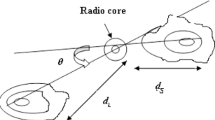Abstract
The depolarization asymmetry seen in double-lobed radio sources, referred to as the Laing-Garrington (L-G) effect where more rapid depolarization is seen in the lobe with no visible jet as the wavelength increases, can be explained either by internal differences between the two lobes, or by an external Faraday screen that lies in front of only the depolarized lobe. If the jet one-sidedness is due to relativistic beaming the depolarization asymmetry must be due to an intervening Faraday screen. If it is intrinsic the depolarization asymmetry must be related to internal differences in the lobes. For a random viewing angle distribution, which must be the case here where un-beamed lobe radiation dominates, jet one-sidedness is unrelated to viewing angle and therefore cannot be used either to estimate the viewing angle or to imply beaming. The outflow speed in the kpc jet is notoriously difficult to determine. However, although it has not yet been proven conclusively, we assume in this paper that the speed in the outer jet of several Fanaroff-Riley Class 1 (FRI) sources exhibiting the L-G effect is close to the 0.1c reported by several other investigators. For these sources we find that the jet one-sidedness cannot be explained by beaming and therefore must be intrinsic. In these FRI sources the L-G effect must be due to differences that originate inside the lobes themselves, with the outer regions of the relevant lobe acting as a Faraday screen. Although it is not known if the flow in the outer jets of FRII sources also slows to this speed it is suggested that the explanation of the L-G effect is likely to be the same in both types. This argument is strengthened by the recent evidence that FRII galaxies have very large viewing angles, which in turn implies that the L-G model cannot work regardless of the jet velocity. It may therefore be too soon to completely rule out internal depolarization in the lobes as the true explanation for the L-G effect.




Similar content being viewed by others
References
Alexander, P., Leahy, J.P.: Mon. Not. R. Astron. Soc. 225, 1 (1987)
Barthel, P.D.: Astrophys. J. 336, 606 (1989)
Bell, M.B.: Int. J. Astron. Astrophys. 2(1), 52–61 (2012). doi:10.4236/ijaa.2012.21008
Bell, M.B., Comeau, S.P.: Astrophys. Space Sci. 325, 31 (2010)
Best, P.N., Carilli, C.L., Garrington, S.T., Longair, M.S., Röttgering, H.J.A.: Mon. Not. R. Astron. Soc. 299, 357 (1998)
Bicknell, G.V.: Astrophys. J. 422, 542 (1994)
Bridle, A.H.: Radio maps located at the following web address (2006). http://www.cv.nrao.edu/~abridle/images.htm
Bridle, A.H., Perley, R.A.: Annu. Rev. Astron. Astrophys. 22, 319 (1984)
Cleary, K., Lawrence, C.R., Marshall, J.A., Hao, L., Meier, D.: Astrophys. J. 660, 117 (2007)
Dreher, J.W., Carilli, C.L.: Astrophys. J. 316, 611 (1987)
Drouart, D.G., et al.: Astron. and Astrophys. 548, A45 (2012)
Fanaroff, B.L., Riley, J.M.: Mon. Not. R. Astron. Soc. 167, 31 (1974)
Garrington, S.T., Conway, R.G.: Mon. Not. R. Astron. Soc. 250, 198 (1991)
Garrington, S.T., Leahy, J.P., Conway, R.G., Laing, R.A.: Nature 331, 149 (1988)
Goodlet, J.A., Kaiser, C.R., Best, P.N., Dennett-Thorpe, A.: Mon. Not. R. Astron. Soc. 347, 508 (2004)
Gopal-Krishna, Wiita, P.J.: Astrophys. J. 529, 189 (2000)
Hocuk, S., Barthel, P.D.: Astron. Astrophys. 523, A9 (2010)
Kellermann, K.I., et al.: Astrophys. J. 609, 539 (2004)
Kovalev, Y.Y., Lister, M.L., Homan, D.C., Kellermann, K.I.: Astrophys. J. 668, L27 (2007)
Laing, R.A.: Nature 331, 149 (1988)
Laing, R.A., Bridle, A.H.: Mon. Not. R. Astron. Soc. 228, 557 (1987)
Laing, R.A., Bridle, A.H.: Mon. Not. R. Astron. Soc. 336, 328 (2002a)
Laing, R.A., Bridle, A.H.: Mon. Not. R. Astron. Soc. 336, 1161 (2002b)
Laing, R.A., Bridle, A.H.: (2007). arXiv:0801.0147
Laing, R.A., Parma, P., De Ruiter, H.R., Fanti, R.: Mon. Not. R. Astron. Soc. 306, 513 (1999)
Laing, R.A., Canvin, J.R., Bridle, A.H., Hardcastle, M.J.: Mon. Not. R. Astron. Soc. 372, 510 (2006)
Lister, M.L., Marscher, A.: Astrophys. J. 476, 572 (1997)
Liu, R., Pooley, G.: Mon. Not. R. Astron. Soc. 249, 343 (1991)
López-Corredoira, M., Perucho, M.: Astron. Astrophys. 544, A56 (2012)
Morganti, R., et al.: Astron. Astrophys. 326, 919 (1997)
O’Dea, C.P., Owen, F.N.: Astrophys. J. 301, 841 (1986)
O’Dea, C.P., Daly, R.A., Kharb, P., Freeman, K.A., Baum, S.A.: Astron. Astrophys. 494, 471 (2009)
Perley, R.A., Bridle, A.H., Willis, A.G.: Astrophys. J. Suppl. Ser. 54, 292 (1984)
Urry, C.M., Padovani, P.: Publ. Astron. Soc. Pac. 107, 803 (1995)
Saripalli, L., Astron. J. 144, 85 (2012)
Vermeulen, R.C., Cohen, M.H.: Astrophys. J. 430, 467 (1994)
Walker, R.C., Walker, M.A., Benson, J.M.: Astrophys. J. 335, 668 (1988)
Author information
Authors and Affiliations
Corresponding author
Rights and permissions
About this article
Cite this article
Bell, M.B., Comeau, S.P. On the depolarization asymmetry seen in giant radio lobes. Astrophys Space Sci 344, 205–210 (2013). https://doi.org/10.1007/s10509-012-1310-4
Received:
Accepted:
Published:
Issue Date:
DOI: https://doi.org/10.1007/s10509-012-1310-4




